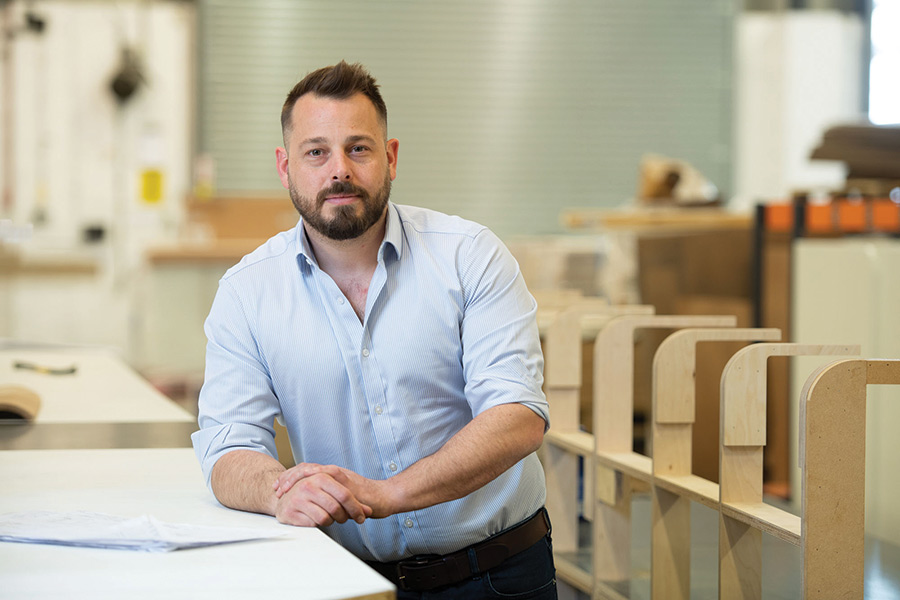By Matt Cater, Owner of FATHOM
Our industry thrives on visual storytelling and impact-driven retail display, but the quest for ever more innovative design can overlook environmental impact. As flooring businesses navigate a future shaped by conscious consumerism and increasing regulation, sustainable practices are no longer optional.
Circular thinking offers the sector a compelling framework: one that prioritises longevity, responsibility and environmental efficiency. It’s a strategic imperative that should underpin every stage of display design, from supplier selection to end-of-life planning. The goal isn’t perfection – it’s progress. And it’s progress that we must pursue together.
Start with the supply chain
Sustainability starts long before a display reaches the showroom floor. It begins with the choices we make in sourcing materials and the partners we choose to work with. Across the industry, there’s increasing scrutiny not only on what materials are used but also on how they’re produced, transported and certified.
Responsible sourcing means selecting timber from FSC-certified forests, choosing finishes with low or zero VOC ratings and partnering with suppliers who can prove their environmental and ethical credentials. Tools such as EcoVadis and POPAI’s PASS accreditation offer an independent benchmark for evaluating corporate sustainability, giving retailers and manufacturers a clearer view of how their choices stack up.
Design for longevity and modularity
All too often, retail display is viewed with a throwaway approach, where the physical structure is created for a single season, campaign or product line. This short-sighted mindset inevitably leads to unnecessary waste, both environmentally and financially. Of course, flooring displays must evolve with commercial needs, but without being torn down and replaced in the process.
The alternative is to design with longevity and flexibility in mind. Modular structures allow components to be reused, reconfigured, refreshed and repaired over time, accommodating changes in product range or branding without starting from scratch. Simple interventions, such as interchangeable graphics, standardised fixtures and tool-free assembly, can dramatically extend a display’s lifespan while reducing labour and cost.
There is great creative potential that comes from designing displays as systems rather than standalones – our POPAI-nominated display for Karndean does exactly that, with pioneering, fully recyclable, single-sided LVT sample boards.
Support responsible end-of-life outcomes
One of the least talked-about but most critical stages in a display’s life is its end. Not every display is made from recyclable materials, but that doesn’t mean we can’t take responsibility for what happens next. Components and materials end up in landfill, perhaps because recycling is perceived as complicated or reuse hasn’t been considered, and this is precisely where circular thinking must step in.
Responsible end-of-life outcomes begin with design. By using mono-material construction where possible, we make recycling easier. By avoiding glued laminates or excessive branding, we enable repurposing. And by documenting material breakdowns and disassembly instructions, with guidance on how components can be responsibly separated, recycled or repurposed, we give retailers the power to act.
But it isn’t just about giving retailers the tools, it’s about creating a culture that normalises these practices and where sustainability is standard procedure. Retailers are increasingly open to displays that balance aesthetics with accountability, but they need suppliers who can provide clear, actionable pathways. The goal is to treat displays not as disposable entities, but as evolving assets in a more thoughtful retail landscape.
Momentum through mindset
Ultimately, progress comes not from mandates but from mindset, and every player in the supply chain has a role to play in driving this shift. Flooring displays are tactile, material-rich and often large-scale, which means the environmental impact is significant, but so is the opportunity for change. Sustainability should be embedded in every phase, from the conceptualisation to the final debrief. That means asking the right questions early on.
For our part, we’re prompting our clients to consider sustainability as part of their design brief, to challenge assumptions and build displays that reflect the values of their brand and their customers. By bringing sustainability into design conversations – and by celebrating those who get it right – it filters through the entire process and builds momentum for a new way of thinking.
Rather than constraining creativity, sustainability can enhance it. Circular thinking encourages smarter, more efficient solutions that serve both commercial goals and environmental responsibility. We’re not claiming to have all the answers, but together, our sector can lead with conviction, display by display, each step paving the way towards a more responsible future.
www.wefathom.com

